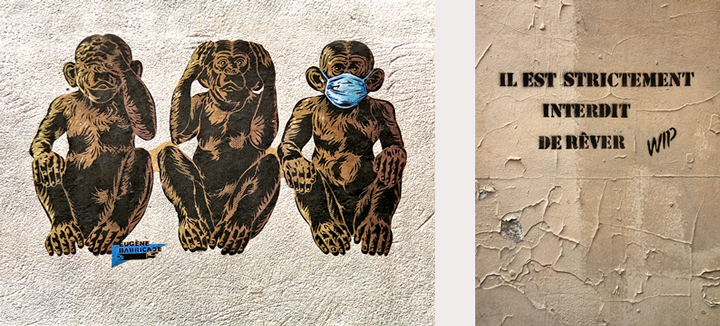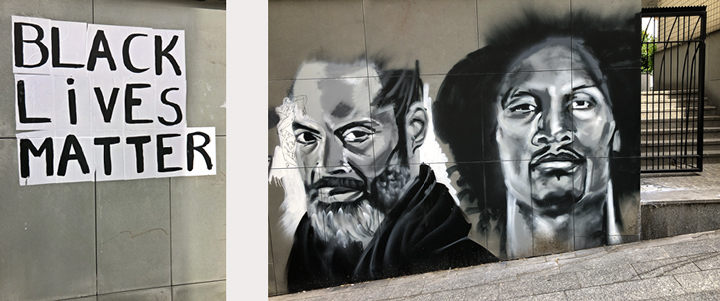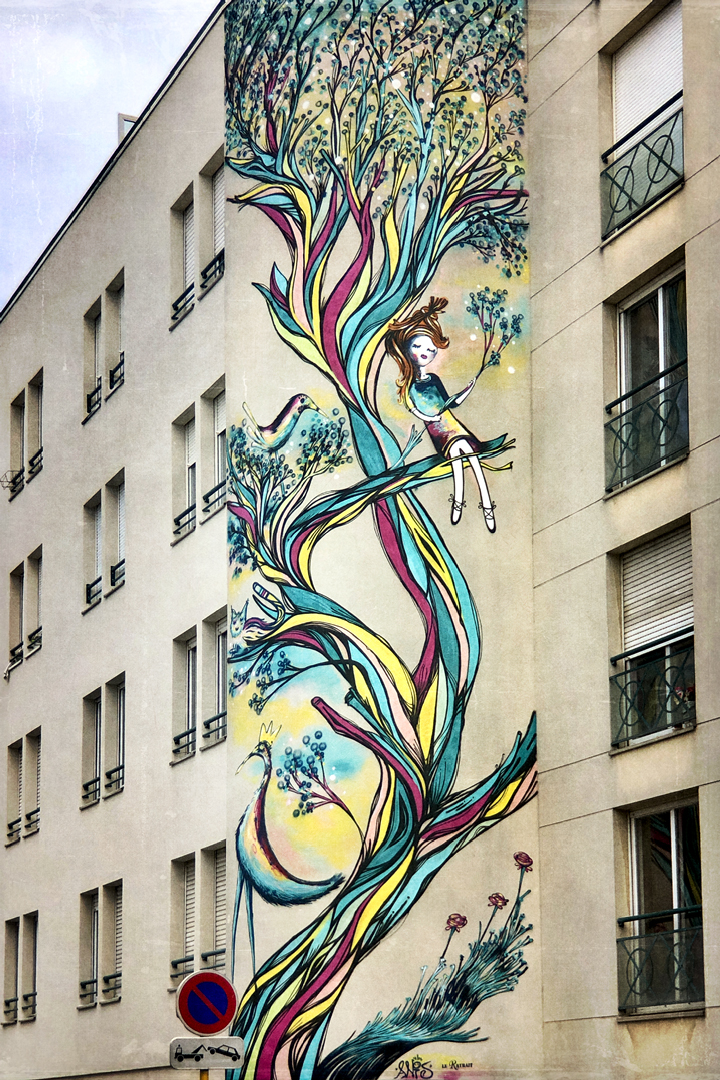
Paris in the time of Covid
I spent the Covid lockdown of late winter and spring 2020 in the rural South of France, in a region that had few cases and very few deaths. Ours was one of the first regions to be declared “green,” which meant that we got to ease out of the restrictions a little more quickly than other parts of France that were labelled orange or red.
As the confinement came to a close in mid-May, my friend Olivier suggested that this summer might be a good time to visit Paris. In my mind, Paris is always a good idea (thank you, Audrey Hepburn!), but I really waffled about whether to make this trip. Traveling from a region with low numbers for the disease into a red-zone city that saw a high number of cases and deaths was enough of a risk to give me pause. Eventually I decided to go, mainly to see what Paris would look like without the crowds. Today’s post is a little journal of my visit to the City of Light.
I took the train, wearing my mandatory face mask for the duration of the journey. When I arrived at the Gare de Lyon, there were no taxis waiting at the huge taxi stand outside, due to strikes. Zut alors! I really didn’t feel like heaving my suitcase, small as it was, through the Paris métro. Just then, a fellow approached me and asked if I’d be interested in a moto taxi, I said oui, and off we went in search of his motorcycle.

Rashid, my driver, is an amiable fellow who owns his business, and knows the city like the back of his hand because he’s lived there all his life. We sliced through the streets of Paris like a hot knife in butter, arriving at my apartment in about a third the time a car would have taken. At traffic stops, Rashid proudly showed me photos of his kids, plus a video of his little girl dancing. He was wearing a Muhammad Ali T-shirt with one of my all-time favorite quotes: “Float like a butterfly, sting like a bee.”
As I was paying for my moto-taxi, I heard my name called, which is weird because I know about five people in all of Paris. I looked up to see Christophe de Oliveira smiling and holding his arms open for a hug. Chris and his wife Angie have a vacation-rental business in Paris by the name of Artisan Lofts. They own several apartments, and I’m happy to say that none of them is a “regular” apartment that’s been taken out of the pool of available housing for people who live and work in Paris. All of their lofts are former commercial spaces that weren’t being used; Chris and Angie swept in to clean them up and create tiny studio apartments for travelers. I stayed in one of their lofts several years ago when I went to Paris to study French; Chris and Angie invited me to lunch one day, and we’ve remained in touch. Theirs are the first places I check when I’m planning a visit to Paris, because I always know what I’m getting: an interesting place in a good location, at a great price, clean and in good condition, with highly responsive owners.
I finished paying Rashid, then introduced the two men. When Rashid left, Chris and I had an exchange that went along the lines of, “Wow, I wasn’t expecting to see you!” With Covid restrictions in place, I was planning to check into my apartment without the benefit of the usual neighborhood tour that Chris and Angie provide for their guests. But that day, Chris took my suitcase and showed me into the apartment, and then we went out for a drink, where we were shortly joined by Angie. It was really a treat to see them, and we had fun catching up on each others’ lives.
Over the next four days, I put a lot of mileage on my feet, first exploring a little bit of the 15th arrondissement, a neighborhood I hadn’t seen until this trip. I also returned to several areas that I already know fairly well, including the district around Pont Neuf (“New Bridge,” which is the oldest bridge in Paris) and the Saint-Michel Fountain. I peeked into shops, stopped for lunch or a drink, rested on park benches, and walked a lot.
The weather was simply glorious: deep, vivid blue skies, warm but not hot temperatures, no wind. It was ideal strolling weather, and the Parisians were out. To accommodate social-distancing rules, restaurants and cafés had been given special permission to build small wooden platforms in the street so that tables could be set up outdoors. People were eating, drinking, laughing, and talking; they were walking their dogs, shopping, or meeting friends, just as they’ve always done. The difference? Lots of masks (even outdoors), one meter of distance (sometimes followed), and no cheek kisses when people greeted each other. I do miss the cheek kisses.

Things looked a little different in the streets around the Pont Neuf and the Saint-Michel Fountain, because it’s an area that’s frequented by a lot of students and tourists, who in normal times seriously outnumber the Parisians who might be in the area. But of course these are not normal times.
That day, the Pont Neuf was nearly empty of pedestrians, which was a sight so bizarre that I began to feel like I’d entered a parallel universe. I nearly had vertigo. The wide sidewalks on each side of the bridge are usually packed with people doing all kinds of different things. The tourists often pause for a photograph with Notre Dame in the background, their bodies creating islands as people stream around them. The locals tuck their heads down and try to make a beeline for the fastest escape to the other side, often turning sideways to slip between other bodies. The lovers casually stroll hand-in-hand, not noticing how often they’re bumped by everyone else.
I walked along the river to the Saint-Michel Fountain, the biggest wall fountain in Paris, which sits where the Boulevard Saint-Michel arrives at the Seine. The fountain is a common place to meet, and it’s usually covered with people who are either sitting on the low wall or climbing higher for photo ops. The fountain sits in an elongated V-shaped place that is an island between two busy streets. Crossing either of those streets usually means being one of a hundred or more people pushing and dodging each other to get across. But the day that I was there, I counted ten people, including me, crossing the street. It was a jolt: I was still very much in that parallel universe.
And then I felt it. As I stood there, letting my body slowly turn in a complete circle and letting my eyes take in sights that my brain had trouble reconciling, I felt it. I had an almost visceral sense of breathing. The trees were breathing. The ground—even the concrete and asphalt—was breathing. The air itself was pulsing with life and energy.
We’ve all read stories from this spring’s lockdown, about how animals returned to areas they’d previously abandoned. We’ve read of noticeably lower levels of pollution in our biggest cities. It all makes sense to me, because I clearly remember the peace and quiet of no airplanes flying overhead for the few days after 9/11. And as I stood there on a usually-bustling patch of concrete in the heart of Paris, I felt that same peace and quiet; this time, I felt the breath. There was a profound sense of relief, of recharging. Humans take vacations to the beach or the mountains in order to find relaxation, recreation and rejuvenation. Trees and sidewalks have no such opportunity, but they need to breathe, too, and I could feel them grabbing this opportunity.
Of course, there’s a flip side to all that breathing. Because without the hordes of tourists, the other missing element was the small businesses that cater to those tourists. Gone were the sidewalk displays of postcards, Eiffel Tower key chains, and Mona Lisa dishtowels. Most of the cafés and restaurants were open, but not bursting with people. If Kodak were still selling film, there wouldn’t be any big sales, even on such an exquisite day. Paris is one of the top destinations in the world, and the city was definitely feeling the lack of visitors. A tourist destination without tourists means a lot of people who aren’t working: taxi drivers, waiters, tour guides, sales clerks, hotel staff … The cost is great.
On this trip, I didn’t walk over to Notre Dame, instead choosing to take a few minutes to watch the progress on reconstruction from the vantage point of a little park on the left bank, Square René-Viviani. This quiet little park is located in the middle of the bustling Left Bank, home to some of the oldest parts of Paris, lots of tourist shops, fast-food restaurants, and—in normal times—heaving masses of humanity. I like this park, for its greenery and quiet in the midst of all that bustle, and also because it sits almost directly across from Notre Dame, thus providing a fabulous side-view of the great cathedral.
One day, I strolled through the Luxembourg Gardens, and then walked the neighborhood just north of the gardens, doing a lot of window shopping along the way. I walked around the Marais, where I stopped in to a bar I know and said hello to Bastien, the owner. He made me a delicious Arnold Palmer (iced tea and real lemonade), which was perfect for the day and the first time I’ve had one in nearly three years. I walked around the Bastille and Place de la Republique, before heading to the Canal Saint-Martin area. The cafés and bars along the canal were buzzing with locals, while more people were to be found along the banks of the canal, reading, daydreaming, chatting with friends.
And for longer distances, I also used the métro, which I really like and find to be an efficient way of getting around Paris.

After I returned to the south, and because I had traveled from green to red and back to green, I decided to have a Covid test, the kind where they stick a swab up your nose until it feels as if the cotton has summited the upper altitudes of your brain. Within a few hours, I received a text with the results: negative. Yay!
One of the highlights of this trip was a walking tour of Paris street art that Olivier had arranged for us. It was bliss: all that art and creativity, in the company of our friendly and knowledgeable guide, Kasia*, and a lovely day to be outside and walking. The remainder of this post consists of photographs of some of the art we saw that day.
I love the incredible creativity and range of ideas in street art. By its very nature, it is ephemeral, and it’s always fresh. Many artists are working from what is happening right now in society, in politics, in the world, working to express their anger or frustration, to search for justice, or to simply tell stories, as you’ll see below. Other artists seek to express beauty and to spread love in the world. The older artists have spent a lifetime refining their style, building a body of work to showcase a fine combination of skill and artistic expression; many of them are in their 60s and even 70s. Nearly everyone has something to say, something to share with the rest of us, and they usually bring terrific wit, intelligence and versatility to their work.
I do my best to give credit to each artist, but sometimes I just can’t find the names. If you know the name of one of the uncredited artists below, please let me know and I’ll gladly update this post.












* Should you find yourself in Paris and looking for something active, outdoors, unique and fascinating, check out Kasia Klon’s street art walking tours:
Telephone: +33 6 10 48 11 47
Website: Street Art Tour Paris
Parting shot
No matter where you live, the pandemic is still very much part of our lives. And that means that a little humor might be helpful! Here are two funnies that I’ve recently seen. Stay safe and be well.


I loved my sojourn in Paris with you just now! Thank you, dear cousin, for rekindling fond memories when Mom & I we’re there 3 times, ‘99, ‘00 (when le tour Eiffel first lit up) and ‘02. One of my fav places on earth!
LikeLike
Dearest Patty, thanks so much for traveling along with me! I’m glad you got to return to all those great memories of your own visits to Paris.
bisous, Lynne
LikeLike